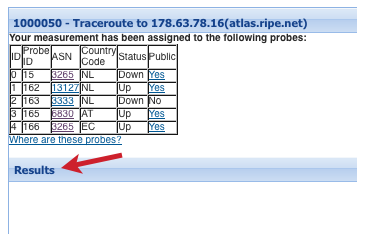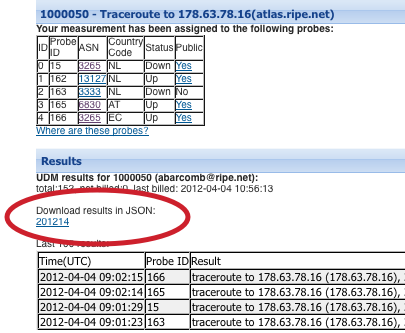With the introduction of a new firmware version for RIPE Atlas probes, the structure of the measurement results will be changing. Anyone making use of the raw results is advised to read about these upcoming changes and to subscribe to our RSS feed or subscribe to our mailing list to be notified of future firmware releases.
This article was changed after publication. It was updated on 19 June, 2012 to include a link to the RIPE Atlas mailing list.
Background
With user-defined measurements (UDM), RIPE Atlas hosts, sponsors and LIRs are able to check the reachability of their servers from many vantage points around the globe.In addition to the result graphs for pings, and the tabular results for ping and traceroute, it is possible to download results of UDMs in JSON format, as shown in Figures 1 and 2.


Measurement results can also be downloaded if you are a probe host.
Upcoming Changes
We are releasing a new probe firmware version, 4460, which will change the format of the raw measurement results for probes running this version. Probes running the older firmware will continue to produce results in the existing format. This means that the results could be made up of a combination of the two formats, especially with long-running measurements.
It is therefore important to adjust any applications which make use of this data to interpret both types of results. The key to identifying the result version is found in fw , which specifies the firmware version. Presently, there are three variations in use: '1' (identified as '1'), '4400' (identified as a number in the range 4400 - 4459) and '4460' (identified as a number greater than or equal to 4460). In the future, the upper bound of the 4460 version will be defined by the new release, just as the upper limit to 4400 was set by the release of 4460.
As of version 4400, a wealth of new information is available, including error messages and more key-value (as opposed to string) presentations of the results. Several new types of measurements are also made possible with the release of this version - look for RIPE Labs articles announcing new types of measurements in the near future! To begin working with the new data structures, refer to the detailed documentation on the data structure .
If you are making use of raw data from RIPE Atlas, it is recommended that you follow our RSS feed or subscribe to the RIPE Atlas mailing list for future announcements of new firmware releases.
Colophon
The lead image for this article was taken in Kiev. No animals or probes were harmed while taking this picture, and the probe is now busy measuring from its new home!

We're always interested in pictures of your probes (connected or just before they're connected - don't disconnect one for a photoshoot!). Tweet it with the hashtag #RIPEAtlas, or email mcb@ripe.net .





Comments 0
The comments section is closed for articles published more than a year ago. If you'd like to inform us of any issues, please contact us.